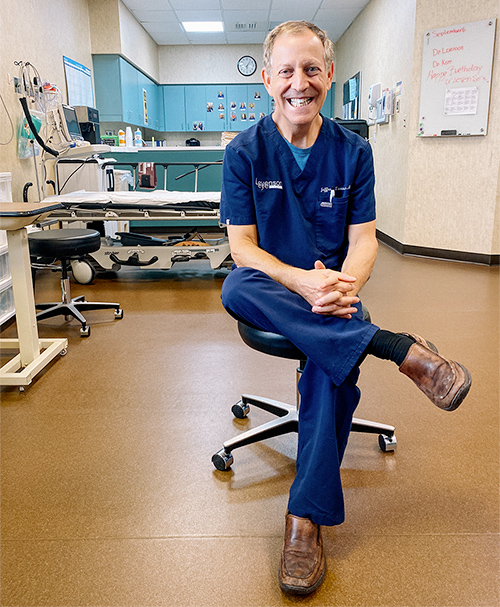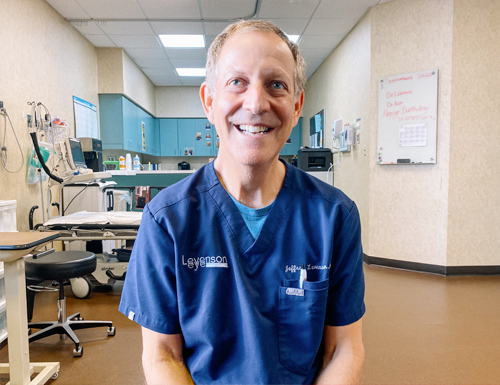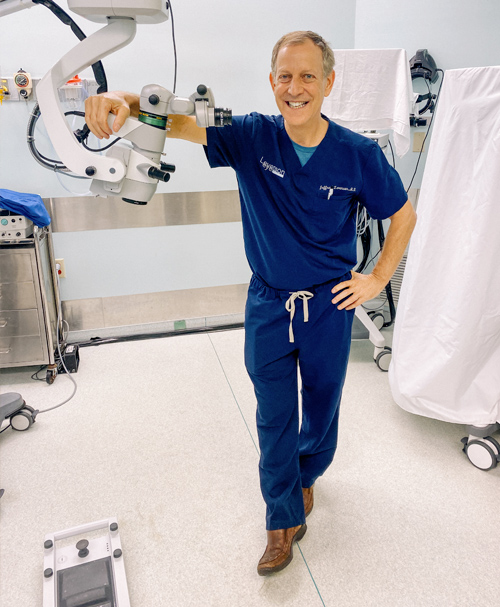Cataracts are the leading cause of blindness worldwide—accounting for half of the world's 40 million blind1.
However, only a small percentage of people who develop them in third-world nations can receive treatment1.
From reading, to driving, to working—vision is an important part of daily life that significantly impacts people’s ability to support themselves and their families. But, cataract surgery is not always accessible or affordable for many of them. That’s where ophthalmologists like Dr. Jeffrey Levenson step in—to donate their time and Make Vision Possible.

Dr. Levenson sits in the patient pre-op area at his eye clinic in Jacksonville, FL.
A cataract occurs when the eye's natural lens becomes cloudy. Proteins in the lens break down and cause things to look blurry, hazy or less colorful2. If left untreated, the blurriness may become progressively worse and ultimately result in complete blindness.
Vision Made Personal
These are symptoms Dr. Levenson, an ophthalmologist from Jacksonville, Florida, would often hear his patients discuss.
Then, at age 51, Dr. Levenson found himself needing cataract surgery after realizing he could not clearly see his wife on the other side of the room.
While his vision was restored at a local medical center, he had the revelation that not everyone enjoyed that same privilege.
“In the weeks after my surgery, I was struck by how simple the surgery was—how curative it was. But at the same time, I was struck by the notion that had I been born elsewhere, had I been born in the mountains of Peru or the slums of San Salvador, I might progressively grow blind and spend the rest of my days waiting for a surgery that I couldn’t afford,” he said.
To pursue his passion of helping patients without access to vision care, Dr. Levenson began working with an organization called SEE International, a humanitarian organization that brings free eye health services to people in 45 countries. He became SEE’s Chief Medical Officer, working with a global team of 350 volunteer ophthalmologists. Then, in 2022, Levenson’s dream to help others gained greater visibility when he partnered with a popular YouTube creator to remove cataracts from 1,000 blind people in underserved communities in the U.S., Namibia, Mexico, Indonesia, and Brazil.

Sitting in the patient pre-op area at his Jacksonville-based eye clinic, Dr. Levenson reflects on his personal journey with cataracts. He received cataract surgery at age 51.

Dr. Levenson stands in the operating room at his eye clinic in Jacksonville, FL.
Vision Made Possible
Dr. Levenson’s most recent assignment in May 2023 took him to the city of Urdaneta in the Philippines. In collaboration with Johnson & Johnson MedTech, who provided almost $150,000 toward the procedures, he and a team of local doctors set out to perform an ambitious 2,500 cataract surgeries in just one week’s time. The project also pulled together the support of Operation Klaro, the Himalayan Cataract Foundation, the Philippine Medical Associations, the International Academy of Medical Specialists, and the local Filipino government in a collaborative effort to correct preventable blindness.
One method of surgery called MSICS, involves making a small incision in the eye, extracting the clouded lens, and replacing it with a clear synthetic plastic lens3. As pioneers in ophthalmology, Johnson & Johnson MedTech aims to deliver innovative cataract solutions for improved patient outcomes.
Levenson’s medical team included many Filipino healthcare practitioners, including ophthalmologists who volunteered their time and brought their own motivation to the project. They weren’t just treating blindness; they were giving hope and quality of life back to patients, families and communities.
Vision Made Reality
Following surgery, one of Levenson’s patients was able to see her daughter for the first time in years and almost didn’t recognize her because of how much she had grown. Another patient invited Levenson back to her home to watch the clouds go by, a simple pleasure she had not been able to enjoy for quite some time.
“I had the opportunity to visit the homes of some of the people we treated earlier in the week, and it’s extraordinary to see the changes that occur when they’re relieved from blindness after years and years in darkness,” Dr. Levenson shared.
“It frees them,” Levenson added. “It frees their families. It frees their communities from the burden of needless blindness.”
To Dr. Levenson, every one of his patients is an inspiration and a small step on the road to eliminating needless blindness around the world. At Johnson & Johnson MedTech, we are so proud to have the opportunity to support these life-changing missions. In partnership with Johnson & Johnson MedTech, Dr. Levenson plans to complete 4,000 surgeries this year in the Philippines.
For more information about Dr. Levenson and SEE International on their mission to end preventable blindness, visit SEE International’s website.
1 Isaacs R, Ram J, Apple D. Cataract blindness in the developing world: is there a solution? J Agromedicine. 2004;9(2):207-20. PMID: 19785217.
2 Boyd, K. (2022, September 06). What Are Cataracts? https://www.aao.org/eye-health/diseases/what-are-cataracts
3 Gurnani B, Kaur K. Manual Small Incision Cataract Surgery. [Updated 2023 Jun 11]. In: StatPearls [Internet]. Treasure Island (FL): StatPearls Publishing; 2023 Jan-. Available from: https://www.ncbi.nlm.nih.gov/books/NBK582123/
PP2023OTH6035

